Traditional Mexican cuisine is a vibrant and complex culinary heritage that reflects the country’s rich history and diverse culture, and at gaymexico.net, we celebrate its inclusivity and appeal to everyone, including the LGBTQ+ community. This culinary tradition is more than just food; it’s a cultural model encompassing farming practices, age-old skills, and community customs. Dive into the heart of Mexico’s gastronomic wonders with us, exploring flavors, ingredients, and traditions that make it a global treasure, while discovering destinations and experiences that embrace diversity and acceptance. Prepare your palates for a journey through ancestral dishes, culinary heritage, and regional specialties!
1. What Defines Traditional Mexican Cuisine?
Traditional Mexican cuisine is a comprehensive cultural model encompassing farming, ritual practices, age-old skills, culinary techniques, and ancestral community customs. It is more than just food. It represents a way of life that has been passed down through generations. This complex culinary heritage is characterized by its deep roots in indigenous traditions, combined with influences from Europe and other parts of the world.
- A Comprehensive Cultural Model: It goes beyond mere cooking, embodying a deep connection to the land, community, and history.
- Farming and Agriculture: The cuisine is closely linked to traditional farming methods, ingredients, and agricultural practices.
- Community Customs: Food plays a central role in social gatherings, festivals, and everyday life, strengthening community bonds.
2. What Are The Key Elements Of Traditional Mexican Food?
The key elements of traditional Mexican food are the ingredients, methods, and cultural context that define this vibrant cuisine. Corn, beans, and chili peppers form the holy trinity. These are not just ingredients. They are the foundation upon which countless dishes are built.
- Corn, Beans, and Chili: These are the essential ingredients, forming the base of many dishes.
- Unique Farming Methods: Techniques like milpas and chinampas showcase agricultural innovation. Milpas are rotating swidden fields of corn and other crops. Chinampas are man-made farming islets in lake areas.
- Nixtamalization: This ancient process of treating corn with lime enhances its nutritional value.
3. What Role Does Corn Play in Traditional Mexican Cuisine?
Corn plays a foundational role in traditional Mexican cuisine, serving as a staple ingredient and holding deep cultural significance. It is not merely a food source. It is a symbol of life, sustenance, and heritage.
- Staple Ingredient: Corn is used in countless dishes, from tortillas and tamales to atole and pozole.
- Cultural Significance: Corn is deeply embedded in Mexican mythology, rituals, and everyday life.
- Nixtamalization Process: Treating corn with lime not only improves its nutritional value but also its flavor and texture.
4. How Does Nixtamalization Enhance the Nutritional Value of Corn?
Nixtamalization is a traditional process that significantly enhances the nutritional value of corn. This alkaline cooking technique involves soaking and cooking corn in an alkaline solution, usually limewater, followed by washing and hulling.
- Releases Nutrients: The process makes niacin (vitamin B3) and other nutrients more bioavailable.
- Increases Calcium: Adds calcium to the corn, which is essential for bone health.
- Improves Protein Quality: Enhances the balance of amino acids in the corn.
5. What Are Milpas and Chinampas and Why Are They Important?
Milpas and chinampas are traditional farming methods that have sustained Mexican agriculture for centuries. They are not just agricultural techniques. They are testaments to the ingenuity and resourcefulness of indigenous communities.
- Milpas: Rotating swidden fields where corn is grown alongside beans, squash, and other crops, promoting biodiversity and soil health.
- Chinampas: Artificial islands or floating gardens built in shallow lake beds, providing fertile ground for year-round cultivation.
- Sustainable Agriculture: Both methods promote sustainable agriculture by maximizing resource use and minimizing environmental impact.
6. What Native Ingredients Complement the Basic Staples in Mexican Cooking?
Beyond corn, beans, and chili, a variety of native ingredients enrich the flavors and textures of traditional Mexican cuisine. These ingredients are not just additions; they are essential components that contribute to the depth and complexity of Mexican dishes.
- Tomatoes: Used in salsas, stews, and sauces, providing acidity and sweetness.
- Avocados: Enjoyed fresh, mashed into guacamole, or used as a creamy topping.
- Cocoa: Used in savory and sweet dishes, adding richness and depth of flavor.
- Vanilla: Aromatic flavoring used in desserts and beverages.
- Squashes: Versatile ingredient used in soups, stews, and side dishes.
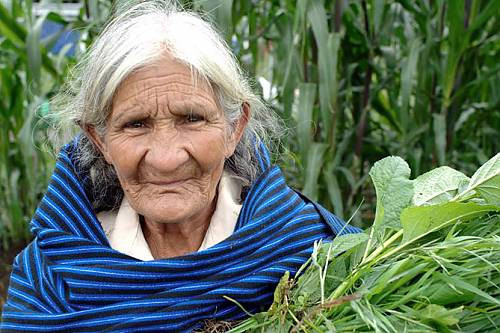 Assortment of colorful vegetables including tomatoes, squash and avocados
Assortment of colorful vegetables including tomatoes, squash and avocados
7. How is Traditional Mexican Cuisine Elaborate and Symbol-Laden?
Traditional Mexican cuisine is renowned for its complexity and symbolic significance, deeply interwoven with cultural practices and historical narratives. The dishes are not mere sustenance. They are expressions of identity, history, and spirituality.
- Day of the Dead Offerings: Foods like tortillas and tamales are integral parts of altars, honoring ancestors and celebrating life.
- Ritualistic Preparation: Many dishes are prepared with specific rituals and techniques, passed down through generations.
- Symbolic Ingredients: Each ingredient often carries symbolic meaning, reflecting cultural values and beliefs.
8. Who Are the Key Practitioners of Traditional Mexican Cuisine?
The key practitioners of traditional Mexican cuisine are primarily women, who safeguard and transmit ancestral knowledge. They are not just cooks; they are cultural guardians, preserving traditions and ensuring their continuity.
- Female Cooks: Women play a central role in preserving and promoting traditional cooking methods and recipes.
- Community Collectives: Groups dedicated to raising crops and preparing traditional dishes strengthen community bonds.
- Local and Regional Identities: Their knowledge and techniques reinforce local, regional, and national identities.
9. How Does Traditional Mexican Cuisine Contribute to Sustainable Development?
Traditional Mexican cuisine contributes significantly to sustainable development by promoting biodiversity, supporting local economies, and preserving cultural heritage. It is not just about preserving the past; it’s about building a sustainable future.
- Biodiversity: Traditional farming methods like milpas encourage the cultivation of diverse crops.
- Local Economies: Supporting local farmers and producers strengthens regional economies.
- Cultural Heritage: Preserving traditional cuisine ensures the continuation of cultural practices and knowledge.
10. What Makes Mexican Cuisine Unique on the World Stage?
Mexican cuisine stands out on the world stage due to its rich history, unique ingredients, and profound cultural significance. It is not just a collection of recipes; it is a living heritage that reflects the country’s diverse and vibrant culture.
- UNESCO Recognition: Recognized by UNESCO as an Intangible Cultural Heritage of Humanity, highlighting its global importance.
- Fusion of Cultures: Combines indigenous traditions with European influences, creating a unique culinary identity.
- Community and Identity: Food plays a central role in community gatherings, celebrations, and the expression of cultural identity.
11. What are some must-try traditional dishes for LGBTQ+ travelers visiting Mexico?
For LGBTQ+ travelers eager to immerse themselves in authentic Mexican flavors, trying traditional dishes is a must. These dishes are not only delicious but also offer a glimpse into the heart and soul of Mexican culture.
- Mole Poblano: A complex sauce made with chili peppers, chocolate, spices, and nuts, often served with chicken or turkey. The rich, layered flavors are a testament to Mexico’s culinary heritage.
- Chiles en Nogada: Poblano peppers stuffed with a mixture of fruits and meats, topped with a walnut cream sauce and pomegranate seeds, representing the colors of the Mexican flag. This dish is as visually stunning as it is flavorful.
- Tamales: Steamed corn dough pockets filled with savory or sweet fillings, wrapped in corn husks or banana leaves. Each region has its own unique version, making tamales a delightful culinary adventure.
- Pozole: A hearty soup made with hominy, meat (usually pork or chicken), and various toppings like shredded cabbage, radishes, and lime. It’s a comforting and communal dish perfect for sharing.
- Tacos al Pastor: Marinated pork cooked on a vertical spit, served in small tortillas with onions, cilantro, and pineapple. A must-try street food that showcases Mexico City’s culinary prowess.
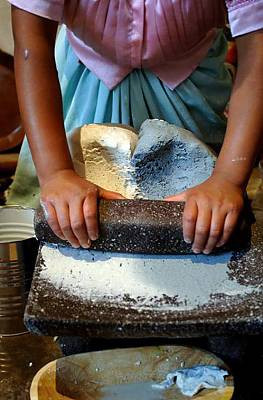 Tacos al pastor with onion and cilantro
Tacos al pastor with onion and cilantro
12. How does gaymexico.net enhance the travel experience for LGBTQ+ individuals in Mexico?
Gaymexico.net enhances the travel experience for LGBTQ+ individuals by providing a wealth of information, resources, and community connections tailored to their needs and interests. It is not just a travel website; it is a gateway to a safe, welcoming, and enriching experience in Mexico.
- Curated Recommendations: Offering insights on LGBTQ+-friendly destinations, accommodations, and activities across Mexico.
- Community Connections: Providing opportunities to connect with local LGBTQ+ communities, fostering a sense of belonging and support.
- Safety Information: Delivering up-to-date information on LGBTQ+ rights, laws, and safety considerations in different regions of Mexico.
13. What are some LGBTQ+-friendly destinations in Mexico known for their culinary scenes?
Several destinations in Mexico are particularly welcoming to LGBTQ+ travelers and boast vibrant culinary scenes that showcase the best of traditional Mexican cuisine. These cities are not only safe and inclusive but also offer a feast for the senses.
- Puerto Vallarta: Known for its stunning beaches, lively nightlife, and diverse culinary offerings, from street tacos to gourmet dining.
- Mexico City: A cosmopolitan hub with a thriving LGBTQ+ scene and a culinary landscape that ranges from traditional mercados to innovative restaurants.
- Guadalajara: The cultural heart of Mexico, offering a rich history, stunning architecture, and a culinary scene that celebrates regional specialties.
14. What are some tips for LGBTQ+ travelers to respectfully experience traditional Mexican cuisine?
To respectfully experience traditional Mexican cuisine, LGBTQ+ travelers should embrace local customs, show appreciation for culinary traditions, and engage with the community in a thoughtful and considerate manner. It’s about being an informed and respectful guest.
- Learn Basic Spanish: Knowing a few basic phrases can enhance interactions with locals and show respect for their culture.
- Support Local Businesses: Patronize family-owned restaurants, street vendors, and artisanal food producers to support the local economy.
- Ask Questions: Show genuine interest in the dishes, ingredients, and cooking methods, and ask questions to learn more about the culinary traditions.
15. How can LGBTQ+ travelers find authentic culinary experiences in Mexico?
LGBTQ+ travelers can discover authentic culinary experiences in Mexico by venturing beyond tourist hotspots and seeking out local recommendations. It’s about getting off the beaten path and exploring the hidden gems.
- Explore Local Markets: Visit traditional markets like Mercado Medellín in Mexico City or Mercado Libertad in Guadalajara to sample regional specialties and interact with local vendors.
- Take Cooking Classes: Participate in a cooking class to learn how to prepare traditional dishes from scratch and gain insights into Mexican culinary techniques.
- Join Food Tours: Embark on a guided food tour to discover hidden culinary gems and learn about the history and culture behind the dishes.
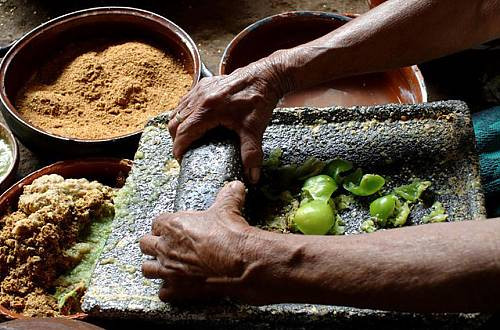 A woman making tortillas
A woman making tortillas
16. What are some common misconceptions about Mexican cuisine that LGBTQ+ travelers should be aware of?
LGBTQ+ travelers should be aware of common misconceptions about Mexican cuisine to better appreciate its diversity and complexity. It’s about dispelling stereotypes and embracing the authentic flavors of Mexico.
- It’s All Spicy: While chili peppers are a key ingredient, not all Mexican dishes are overly spicy. Many dishes offer a balance of flavors, and you can always ask for mild options.
- It’s Just Tacos and Burritos: Mexican cuisine is incredibly diverse, with regional specialties and complex dishes that go far beyond tacos and burritos.
- It’s Unhealthy: Traditional Mexican cuisine, when prepared with fresh, whole ingredients, can be very healthy, offering a balance of nutrients and flavors.
17. How does the concept of “comida corrida” reflect Mexican culture?
The concept of “comida corrida,” or daily meal, reflects Mexican culture through its affordability, accessibility, and community-oriented nature. It’s not just a meal; it’s a social and cultural experience.
- Affordable and Accessible: “Comida corrida” offers a budget-friendly way to enjoy a complete and satisfying meal, making it accessible to people from all walks of life.
- Daily Ritual: It represents a daily ritual for many Mexicans, providing a comforting and familiar dining experience.
- Community-Oriented: “Comida corrida” is often enjoyed in small, family-run restaurants, fostering a sense of community and connection.
18. What regional variations exist in traditional Mexican cuisine?
Regional variations in traditional Mexican cuisine are vast and diverse, reflecting the country’s varied geography, climate, and cultural influences. Each region boasts its own unique specialties, ingredients, and cooking techniques.
- Oaxaca: Known for its complex mole sauces, tlayudas (large crispy tortillas), and chapulines (grasshoppers).
- Yucatán: Famous for its cochinita pibil (slow-roasted pork), sopa de lima (lime soup), and use of achiote paste.
- Puebla: Renowned for its mole poblano, chiles en nogada, and cemitas (stuffed sandwiches).
- Veracruz: Celebrated for its seafood dishes, such as pescado a la Veracruzana (fish in tomato sauce with olives and capers) and arroz a la tumbada (rice with seafood).
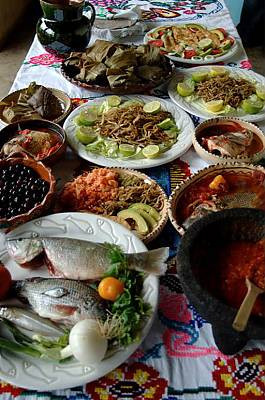 Mole Poblano dish
Mole Poblano dish
19. How do traditional Mexican desserts showcase the country’s culinary creativity?
Traditional Mexican desserts showcase the country’s culinary creativity through their unique ingredients, flavors, and techniques. These sweets are not just an afterthought; they are an integral part of the Mexican culinary experience.
- Churros: Fried dough pastries dusted with cinnamon sugar, often served with chocolate sauce.
- Flan: A creamy custard dessert with a caramel topping, showcasing a blend of indigenous and European influences.
- Arroz con Leche: Rice pudding flavored with cinnamon and sugar, a comforting and classic dessert.
- Cajeta: A caramelized goat’s milk confection, similar to dulce de leche, often used as a filling or topping.
20. What beverages are integral to traditional Mexican meals?
Several beverages are integral to traditional Mexican meals, complementing the flavors of the food and enhancing the dining experience. These drinks are not just thirst-quenchers; they are cultural staples.
- Agua Frescas: Refreshing fruit-flavored waters made with ingredients like hibiscus (jamaica), tamarind (tamarindo), and horchata (rice milk).
- Horchata: A creamy and refreshing beverage made from rice, cinnamon, and sugar, often served over ice.
- Mexican Coffee: Coffee brewed with cinnamon and piloncillo (unrefined cane sugar), offering a warm and aromatic accompaniment to meals.
- Michelada: A savory beer cocktail made with lime juice, hot sauce, spices, and chili salt, a popular choice for brunch or a casual gathering.
21. What spices and herbs are commonly used in traditional Mexican cooking?
Traditional Mexican cooking relies on a diverse array of spices and herbs to create its distinctive flavors. These ingredients are not mere seasonings; they are the building blocks of Mexican cuisine.
- Cumin: Adds a warm, earthy flavor to dishes like chili and stews.
- Oregano: Provides a slightly bitter, aromatic note to soups, sauces, and grilled meats.
- Cinnamon: Used in both sweet and savory dishes, adding warmth and complexity.
- Epazote: A pungent herb with a unique flavor, often used in bean dishes and quesadillas.
- Cilantro: Fresh herb used as a garnish and flavor enhancer in tacos, salsas, and soups.
22. How are traditional Mexican recipes passed down through generations?
Traditional Mexican recipes are typically passed down through generations via oral tradition and hands-on learning, particularly within families. These recipes are not just instructions; they are cherished family heirlooms.
- Oral Tradition: Recipes are often shared verbally, with mothers and grandmothers teaching their daughters and granddaughters the secrets of their culinary heritage.
- Hands-On Learning: Young cooks learn by observing and assisting their elders in the kitchen, mastering techniques and developing a feel for the ingredients.
- Family Cookbooks: Some families compile their recipes into handwritten cookbooks, preserving their culinary legacy for future generations.
23. What kitchen tools are essential for preparing traditional Mexican dishes?
Several kitchen tools are essential for preparing traditional Mexican dishes, reflecting the techniques and ingredients used in this vibrant cuisine. These tools are not just utensils; they are essential components of the Mexican cooking experience.
- Molcajete and Tejolete: A traditional mortar and pestle made from volcanic stone, used for grinding spices, herbs, and making salsas.
- Comal: A flat, round griddle used for cooking tortillas, toasting spices, and roasting vegetables.
- Tortilla Press: A simple device used to flatten balls of masa (corn dough) into thin, even tortillas.
- Olla de Barro: A clay pot used for cooking stews, soups, and beans, imparting a unique earthy flavor.
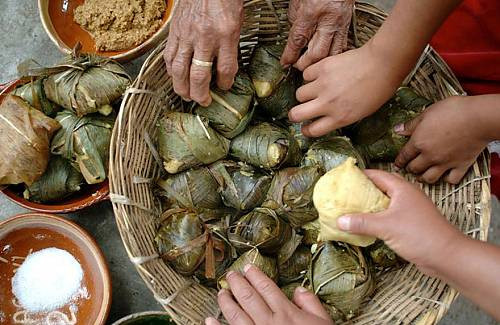 A molcajete and tejolete
A molcajete and tejolete
24. How does street food contribute to Mexico’s culinary identity?
Street food plays a vital role in shaping Mexico’s culinary identity, offering a diverse and accessible taste of the country’s rich gastronomic heritage. It’s not just food; it’s a cultural experience that reflects the vibrancy and diversity of Mexican society.
- Accessibility: Street food is affordable and readily available, making it accessible to people from all walks of life.
- Diversity: From tacos and tamales to elotes (grilled corn) and esquites (corn salad), Mexican street food offers a vast array of flavors and textures.
- Cultural Expression: Street food vendors often use traditional cooking methods and ingredients, preserving culinary traditions and sharing them with a wider audience.
25. What role do markets play in preserving traditional Mexican cuisine?
Markets play a crucial role in preserving traditional Mexican cuisine by providing a space for local farmers, producers, and cooks to showcase their products and culinary skills. They are not just shopping centers; they are cultural hubs that sustain culinary traditions.
- Support Local Producers: Markets provide a direct link between consumers and local farmers and producers, supporting sustainable agriculture and regional economies.
- Preserve Traditional Ingredients: Markets offer a wide variety of traditional ingredients, including heirloom corn, specialty chili peppers, and regional herbs and spices.
- Showcase Culinary Skills: Markets are home to countless food stalls and small restaurants that serve traditional dishes, prepared with time-honored techniques.
26. How does the celebration of Day of the Dead incorporate traditional Mexican cuisine?
The celebration of Day of the Dead (Día de Muertos) deeply incorporates traditional Mexican cuisine as an integral part of honoring and remembering deceased loved ones. Food is not just sustenance; it’s an offering and a connection to the spirit world.
- Offerings to the Deceased: Families create elaborate altars (ofrendas) adorned with food and beverages that were cherished by the deceased, including mole, tamales, pan de muerto (bread of the dead), and atole (a corn-based drink).
- Pan de Muerto: This sweet bread, often decorated with bone-shaped designs and flavored with anise and orange zest, is a symbolic representation of the cycle of life and death.
- Communal Feasts: Families and communities gather to share meals and celebrate the lives of their deceased loved ones, strengthening social bonds and preserving cultural traditions.
27. How does the Mexican government support the preservation of traditional cuisine?
The Mexican government supports the preservation of traditional cuisine through various initiatives, recognizing its cultural and economic importance. It’s about safeguarding a vital part of Mexico’s national identity.
- UNESCO Recognition: The government actively promoted the inscription of traditional Mexican cuisine on UNESCO’s list of Intangible Cultural Heritage of Humanity in 2010.
- Gastronomic Tourism: The government promotes gastronomic tourism, encouraging visitors to explore Mexico’s regional cuisines and support local producers and restaurants.
- Educational Programs: The government supports educational programs and culinary schools that teach traditional Mexican cooking techniques and promote the use of local ingredients.
28. What are some contemporary adaptations of traditional Mexican cuisine?
Contemporary adaptations of traditional Mexican cuisine often involve innovative chefs and restaurants experimenting with new techniques, ingredients, and presentations while staying true to the essence of Mexican flavors. It’s about honoring the past while embracing the future.
- Fusion Cuisine: Chefs blend traditional Mexican ingredients and flavors with international culinary techniques, creating innovative and exciting dishes.
- Modern Presentation: Restaurants offer beautifully plated and artfully presented versions of classic Mexican dishes, elevating the dining experience.
- Sustainable Practices: Chefs prioritize the use of locally sourced, sustainable ingredients, supporting local farmers and promoting environmental responsibility.
29. How can individuals contribute to preserving traditional Mexican cuisine?
Individuals can contribute to preserving traditional Mexican cuisine by supporting local producers, learning traditional cooking techniques, and sharing their culinary heritage with others. It’s about being an active participant in preserving a cultural treasure.
- Support Local Businesses: Patronize family-owned restaurants, street vendors, and artisanal food producers to support the local economy and preserve culinary traditions.
- Learn Traditional Recipes: Take cooking classes, read cookbooks, and learn from family members to master traditional Mexican recipes and techniques.
- Share Your Culinary Heritage: Share your knowledge and love of traditional Mexican cuisine with friends, family, and the wider community, promoting appreciation and understanding.
30. What resources are available for learning more about traditional Mexican cuisine?
Several resources are available for learning more about traditional Mexican cuisine, including cookbooks, websites, culinary schools, and cultural organizations. It’s about exploring the wealth of information available and deepening your understanding of Mexican culinary heritage.
- Cookbooks: Explore cookbooks by renowned Mexican chefs and culinary experts, offering authentic recipes and insights into Mexican culinary traditions.
- Websites: Visit websites dedicated to Mexican cuisine, offering recipes, articles, and information on regional specialties and culinary events. Gaymexico.net is an excellent starting point, offering curated recommendations and community connections for LGBTQ+ travelers.
- Culinary Schools: Enroll in a cooking class or culinary program focused on traditional Mexican cuisine, learning from experienced chefs and mastering essential techniques.
Traditional Mexican cuisine is a celebration of life, community, and culture, and we invite you to explore it with us at gaymexico.net, where diversity is always on the menu.
Address: 3255 Wilshire Blvd, Los Angeles, CA 90010, United States.
Phone: +1 (213) 380-2177.
Website: gaymexico.net.
FAQ About Traditional Mexican Cuisine
1. What makes traditional Mexican cuisine unique?
Traditional Mexican cuisine is unique due to its combination of indigenous ingredients, ancient cooking techniques, and cultural significance, recognized by UNESCO as an Intangible Cultural Heritage.
2. What are the staple ingredients in traditional Mexican cuisine?
The staple ingredients are corn, beans, and chili peppers, forming the base of many dishes and holding deep cultural significance.
3. How does nixtamalization benefit corn in Mexican cooking?
Nixtamalization enhances the nutritional value of corn by releasing nutrients, increasing calcium, and improving protein quality.
4. What role do women play in preserving traditional Mexican cuisine?
Women play a central role as cooks and community members, safeguarding and transmitting ancestral knowledge and techniques through generations.
5. How does traditional Mexican cuisine contribute to sustainable development?
It promotes biodiversity through methods like milpas, supports local economies by using regional ingredients, and preserves cultural heritage.
6. What are some popular traditional dishes for LGBTQ+ travelers to try in Mexico?
Popular dishes include mole poblano, chiles en nogada, tamales, and pozole, offering a diverse taste of Mexican flavors and culinary traditions.
7. How can LGBTQ+ travelers find authentic culinary experiences in Mexico?
LGBTQ+ travelers can explore local markets, take cooking classes, and join food tours to discover hidden culinary gems and regional specialties.
8. What is “comida corrida” and what does it reflect about Mexican culture?
“Comida corrida” is an affordable daily meal reflecting Mexican culture through its accessibility, community-oriented nature, and representation of a daily ritual.
9. What are some regional variations in traditional Mexican cuisine?
Regional variations include Oaxaca with its mole sauces, Yucatán with cochinita pibil, and Puebla with chiles en nogada, each offering unique flavors and ingredients.
10. How can individuals contribute to preserving traditional Mexican cuisine?
Individuals can support local businesses, learn traditional recipes, and share their culinary heritage to promote appreciation and understanding.